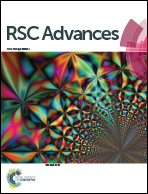Fabrication of nanofibres with azopyridine compounds in various acids and solvents†
Abstract
Supramolecular self-organization behaviours of one azopyridine compound were systematically studied in a series of inorganic acids and various organic solvents. Different morphologies of the resultant low-molecular-weight compounds were obtained in diverse environments. The acid dissociation constant has a critical effect on the self-assembly since the nanofibres were successfully obtained only when the acid dissociation constant is between 2.12 and −3.00. Besides, the organic solvent also influenced the process of fibre formation. In acetone, the self-organized fibrous material resulted in the occurrence of gelation. The driving force for nanofibre formation may be due to the existence of several non-covalent interactions, such as hydrogen bonds, ionic bonds and the aggregation of chromophores. Then, a possible schematic illustration for the fabrication of supramolecularly self-assembled fibres was proposed based on TEM and XRD measurements. That is, visible micron-fibres were made from nanofibres through stacking interaction forces of azopyridine chromophores.


 Please wait while we load your content...
Please wait while we load your content...